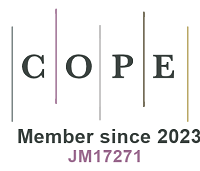REFERENCES
1. Eriksen M, Liboiron M, Kiessling T, et al. Microplastic sampling with the AVANI trawl compared to two neuston trawls in the Bay of Bengal and South Pacific. Environ Pollut 2018;232:430-9.
2. Horton AA, Dixon SJ. Microplastics: an introduction to environmental transport processes. WIREs Water 2018;5:e1268.
3. Paul-pont I, Tallec K, Gonzalez-fernandez C, et al. Constraints and priorities for conducting experimental exposures of marine organisms to microplastics. Front Mar Sci 2018;5:252.
4. Karami A, Golieskardi A, Choo CK, Larat V, Karbalaei S, Salamatinia B. Microplastic and mesoplastic contamination in canned sardines and sprats. Sci Total Environ 2018;612:1380-6.
5. Fadare OO, Okoffo ED. COVID-19 face masks: a potential source of microplastic fibers in the environment. Sci Total Environ 2020;737:140279.
6. Anastopoulos I, Pashalidis I. Single-use surgical face masks, as a potential source of microplastics: do they act as pollutant carriers? J Mol Liq 2021;326:115247.
7. Kumar M, Chen H, Sarsaiya S, et al. Current research trends on micro- and nano-plastics as an emerging threat to global environment: a review. J Hazard Mater 2021;409:124967.
8. Hasan NA, Heal RD, Bashar A, Haque MM. Face masks: protecting the wearer but neglecting the aquatic environment? - A perspective from Bangladesh. Environ Chall 2021;4:100126.
9. Prata JC, Silva ALP, Walker TR, Duarte AC, Rocha-Santos T. COVID-19 pandemic repercussions on the use and management of plastics. Environ Sci Technol 2020;54:7760-5.
10. De-la-Torre GE, Aragaw TA. What we need to know about PPE associated with the COVID-19 pandemic in the marine environment. Mar Pollut Bull 2021;163:111879.
11. Silva AL, Prata JC, Mouneyrac C, Barcelò D, Duarte AC, Rocha-Santos T. Risks of COVID-19 face masks to wildlife: present and future research needs. Sci Total Environ 2021;792:148505.
12. Torres FG, De-la-torre GE. Face mask waste generation and management during the COVID-19 pandemic: an overview and the Peruvian case. Sci Total Environ 2021;786:147628.
13. Worby CJ, Chang HH. Face mask use in the general population and optimal resource allocation during the COVID-19 pandemic. Nat Commun 2020;11:4049.
14. Prata JC, Silva ALP, Duarte AC, Rocha-santos T. Disposable over reusable face masks: public safety or environmental disaster? Environments 2021;8:31.
15. Chowdhury H, Chowdhury T, Sait SM. Estimating marine plastic pollution from COVID-19 face masks in coastal regions. Mar Pollut Bull 2021;168:112419.
16. Aragaw TA. Surgical face masks as a potential source for microplastic pollution in the COVID-19 scenario. Mar Pollut Bull 2020;159:111517.
17. Chua MH, Cheng W, Goh SS, et al. Face masks in the new COVID-19 normal: materials, testing, and perspectives. Research 2020;2020:7286735.
18. Shen M, Zeng Z, Song B, et al. Neglected microplastics pollution in global COVID-19: disposable surgical masks. Sci Total Environ 2021;790:148130.
19. Liu Y, Yang X, Luo L, et al. Long-term release kinetic characteristics of microplastic from commonly used masks into water under simulated natural environments. Sci Total Environ 2023;876:162526.
20. Liang H, Guo R, Liu D, et al. The behavior of microplastics and nanoplastics release from UV-aged masks in the water. Sci Total Environ 2023;891:164361.
21. Jiang H, Su J, Zhang Y, et al. Insight into the microplastics release from disposable face mask: simulated environment and removal strategy. Chemosphere 2022;309:136748.
22. Sunday MO, Jadoon WA, Ayeni TT, et al. Heterogeneity and potential aquatic toxicity of hydrogen peroxide concentrations in selected rivers across Japan. Sci Total Environ 2020;733:139349.
23. Asio JRG, Garcia JS, Antonatos C, Sevilla-nastor JB, Trinidad LC. Sodium lauryl sulfate and its potential impacts on organisms and the environment: a thematic analysis. Emerg Contam 2023;9:100205.
24. Hernandez E, Nowack B, Mitrano DM. Polyester textiles as a source of microplastics from households: a mechanistic study to understand microfiber release during washing. Environ Sci Technol 2017;51:7036-46.
25. Wang T, Li B, Zou X, et al. Emission of primary microplastics in mainland China: invisible but not negligible. Water Res 2019;162:214-24.
26. Saliu F, Veronelli M, Raguso C, Barana D, Galli P, Lasagni M. The release process of microfibers: from surgical face masks into the marine environment. Environ Adv 2021;4:100042.
27. Napper IE, Thompson RC. Release of synthetic microplastic plastic fibres from domestic washing machines: effects of fabric type and washing conditions. Mar Pollut Bull 2016;112:39-45.
28. Chen X, Chen X, Liu Q, Zhao Q, Xiong X, Wu C. Used disposable face masks are significant sources of microplastics to environment. Environ Pollut 2021;285:117485.
29. Akhbarizadeh R, Dobaradaran S, Nabipour I, et al. Abandoned COVID-19 personal protective equipment along the Bushehr shores, the Persian Gulf: an emerging source of secondary microplastics in coastlines. Mar Pollut Bull 2021;168:112386.
30. Enyoh CE, Verla AW, Verla EN, Ibe FC, Amaobi CE. Airborne microplastics: a review study on method for analysis, occurrence, movement and risks. Environ Monit Assess 2019;191:668.
31. Sun J, Yang S, Zhou GJ, et al. Release of microplastics from discarded surgical masks and their adverse impacts on the marine copepod Tigriopus japonicus. Environ Sci Technol Lett 2021;8:1065-70.
32. Jiang H, Luo D, Wang L, Zhang Y, Wang H, Wang C. A review of disposable facemasks during the COVID-19 pandemic: a focus on microplastics release. Chemosphere 2023;312:137178.
33. Ardusso M, Forero-López AD, Buzzi NS, Spetter CV, Fernández-Severini MD. COVID-19 pandemic repercussions on plastic and antiviral polymeric textile causing pollution on beaches and coasts of South America. Sci Total Environ 2021;763:144365.
34. Song YK, Hong SH, Jang M, Han GM, Jung SW, Shim WJ. Combined effects of UV exposure duration and mechanical abrasion on microplastic fragmentation by polymer type. Environ Sci Technol 2017;51:4368-76.
35. Zhang K, Hamidian AH, Tubić A, et al. Understanding plastic degradation and microplastic formation in the environment: a review. Environ Pollut 2021;274:116554.
36. Castro-Jiménez J, González-Fernández D, Fornier M, Schmidt N, Sempéré R. Macro-litter in surface waters from the Rhone River: plastic pollution and loading to the NW Mediterranean Sea. Mar Pollut Bull 2019;146:60-6.
37. Kane IA, Clare MA, Miramontes E, et al. Seafloor microplastic hotspots controlled by deep-sea circulation. Science 2020;368:1140-5.
38. Torres-Agullo A, Karanasiou A, Moreno T, Lacorte S. Overview on the occurrence of microplastics in air and implications from the use of face masks during the COVID-19 pandemic. Sci Total Environ 2021;800:149555.
39. Cooper DA, Corcoran PL. Effects of mechanical and chemical processes on the degradation of plastic beach debris on the island of Kauai, Hawaii. Mar Pollut Bull 2010;60:650-4.
40. Dharmaraj S, Ashokkumar V, Hariharan S, et al. The COVID-19 pandemic face mask waste: a blooming threat to the marine environment. Chemosphere 2021;272:129601.
41. Morgana S, Casentini B, Amalfitano S. Uncovering the release of micro/nanoplastics from disposable face masks at times of
42. Kenney MC, Mandell JF, Mcgarry FJ. The effects of sea water and concentrated salt solutions on the fatigue of nylon 6,6 fibres. J Mater Sci 1985;20:2060-70.
43. Efimova I, Bagaeva M, Bagaev A, Kileso A, Chubarenko IP. Secondary microplastics generation in the sea swash zone with coarse bottom sediments: laboratory experiments. Front Mar Sci 2018;5:313.
44. Thompson RC, Olsen Y, Mitchell RP, et al. Lost at sea: where is all the plastic? Science 2004;304:838.
46. Murphy F, Ewins C, Carbonnier F, Quinn B. Wastewater treatment works (WwTW) as a source of microplastics in the aquatic environment. Environ Sci Technol 2016;50:5800-8.
47. Reid AJ, Carlson AK, Creed IF, et al. Emerging threats and persistent conservation challenges for freshwater biodiversity. Biol Rev Camb Philos Soc 2019;94:849-73.
48. Aragaw TA, Mekonnen BA. Distribution and impact of microplastics in the aquatic systems: a review of ecotoxicological effects on biota. In: Muthu SS, editor. Microplastic Pollution. Singapore: Springer; 2021. p. 65-104.
49. Singh RP, Mishra S, Das AP. Synthetic microfibers: pollution toxicity and remediation. Chemosphere 2020;257:127199.
50. Gallo Neto H, Gomes Bantel C, Browning J, et al. Mortality of a juvenile Magellanic penguin (Spheniscus magellanicus, Spheniscidae) associated with the ingestion of a PFF-2 protective mask during the COVID-19 pandemic. Mar Pollut Bull 2021;166:112232.
51. Hiemstra AF, Rambonnet L, Gravendeel B, Schilthuizen M. The effects of COVID-19 litter on animal life. Animal Biol 2021;71:215-31. Available from: https://www.remed-zero-plastique.org/upload/resource/619cd4bd87c84_[15707563%20-%20Animal%20Biology]%20The%20effects%20of%20COVID-19%20litter%20on%20animal%20life.pdf. [Last accessed on 5 Sep 2023]
52. Miller ME, Hamann M, Kroon FJ. Bioaccumulation and biomagnification of microplastics in marine organisms: a review and meta-analysis of current data. PLoS One 2020;15:e0240792.
53. Kutralam-Muniasamy G, Pérez-Guevara F, Elizalde-Martínez I, Shruti VC. An overview of recent advances in micro/nano beads and microfibers research: critical assessment and promoting the less known. Sci Total Environ 2020;740:139991.
54. Santos D, Félix L, Luzio A, et al. Toxicological effects induced on early life stages of zebrafish (Danio rerio) after an acute exposure to microplastics alone or co-exposed with copper. Chemosphere 2020;261:127748.
55. Zheng X, Zhang W, Yuan Y, et al. Growth inhibition, toxin production and oxidative stress caused by three microplastics in Microcystis aeruginosa. Ecotoxicol Environ Saf 2021;208:111575.
56. Klemeš JJ, Fan YV, Tan RR, Jiang P. Minimising the present and future plastic waste, energy and environmental footprints related to COVID-19. Renew Sustain Energy Rev 2020;127:109883.
57. Wang Y, Wang X, Li Y, et al. Effects of exposure of polyethylene microplastics to air, water and soil on their adsorption behaviors for copper and tetracycline. Chem Eng J 2021;404:126412.
58. Alnajar N, Jha AN, Turner A. Impacts of microplastic fibres on the marine mussel, Mytilus galloprovinciallis. Chemosphere 2021;262:128290.
59. Hamed M, Soliman HAM, Osman AGM, Sayed AEH. Assessment the effect of exposure to microplastics in Nile Tilapia
60. Espinosa C, Cuesta A, Esteban MÁ. Effects of dietary polyvinylchloride microparticles on general health, immune status and expression of several genes related to stress in gilthead seabream (Sparus aurata L.). Fish Shellfish Immunol 2017;68:251-9.
61. Meier P, Zabara M, Hirsch C, et al. Evaluation of fiber and debris release from protective COVID-19 mask textiles and in vitro acute cytotoxicity effects. Environ Int 2022;167:107364.
62. Soo XYD, Wang S, Yeo CCJ, et al. Polylactic acid face masks: are these the sustainable solutions in times of COVID-19 pandemic? Sci Total Environ 2022;807:151084.
63. Jiang H, Bu J, Bian K, et al. Surface change of microplastics in aquatic environment and the removal by froth flotation assisted with cationic and anionic surfactants. Water Res 2023;233:119794.







